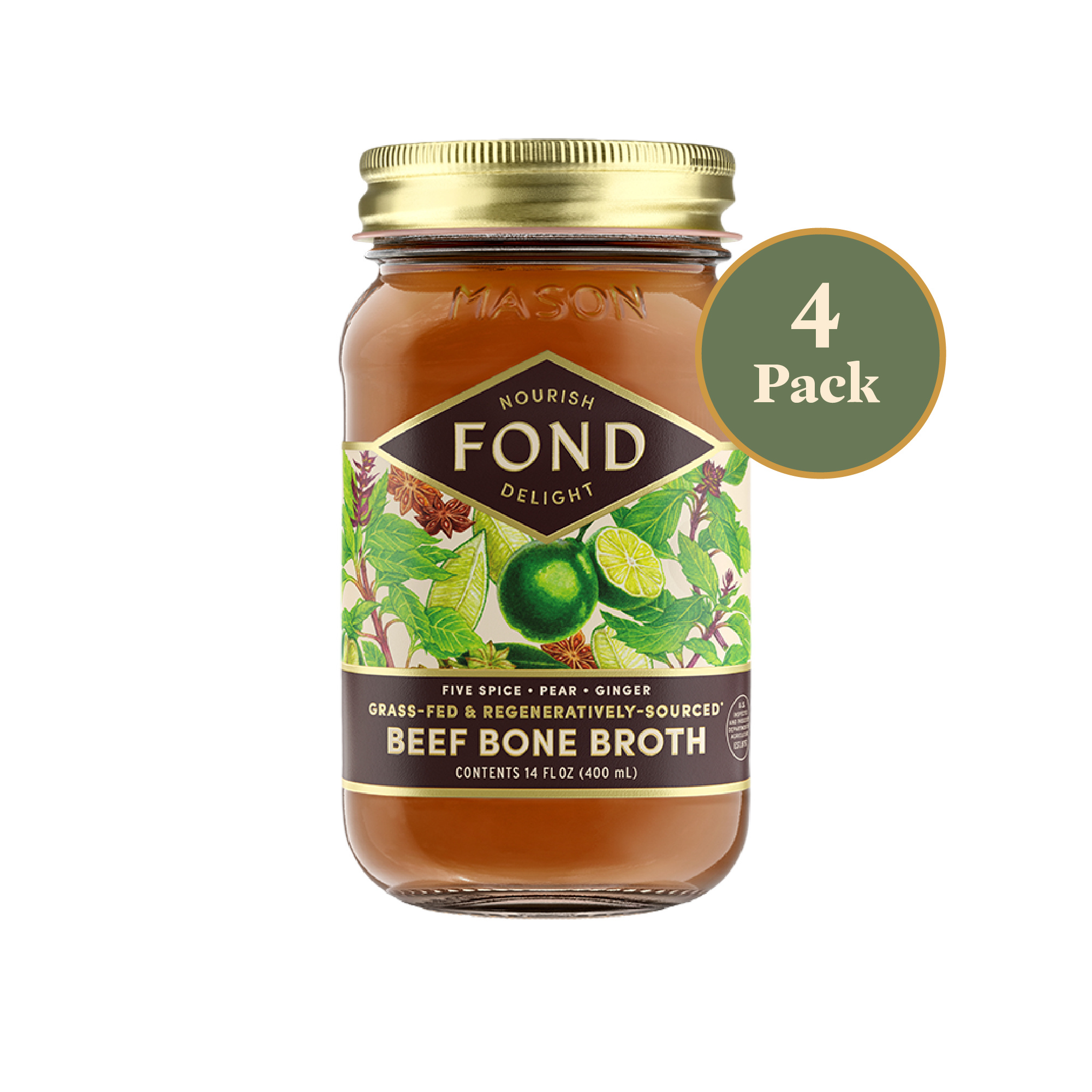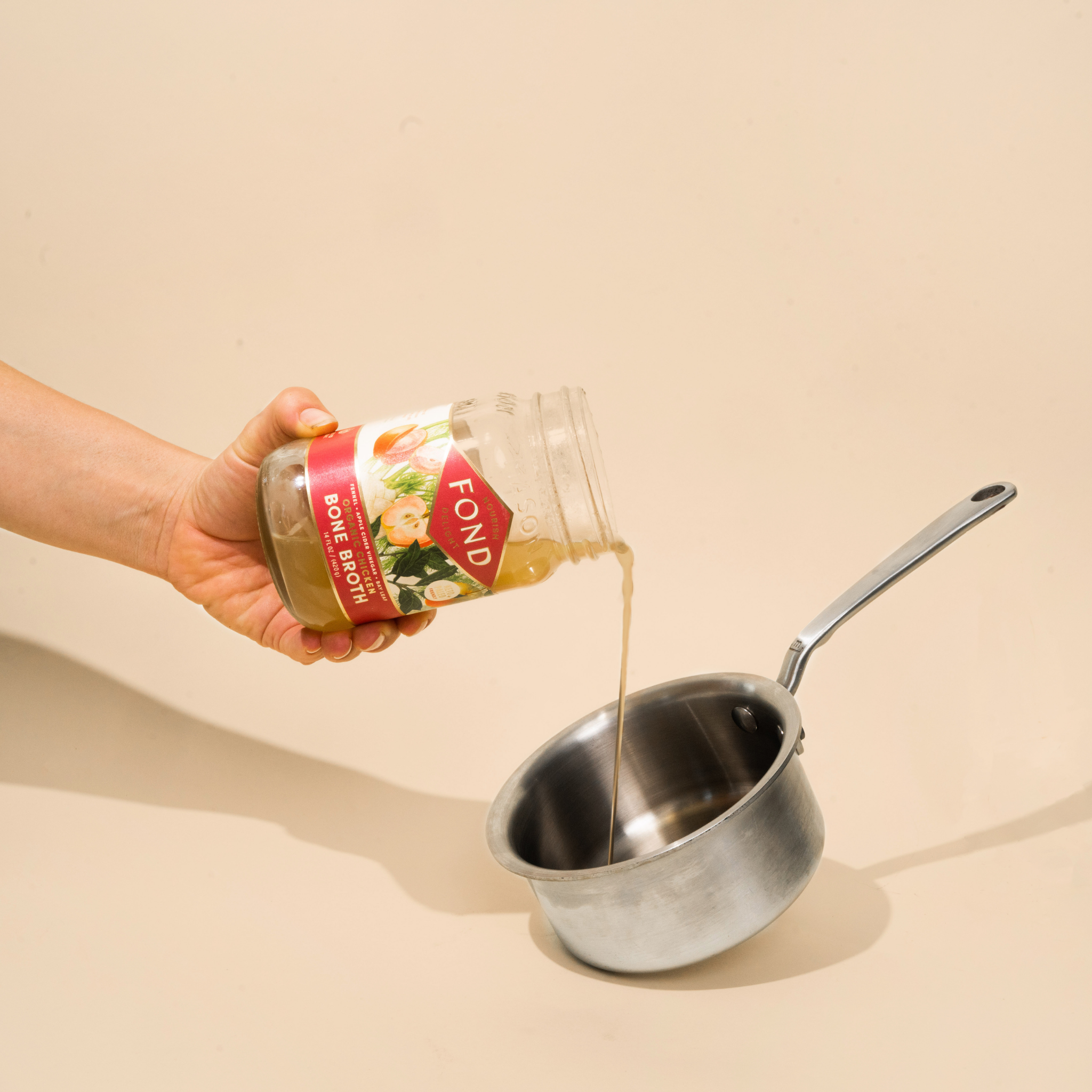The ketogenic diet - termed keto by most - has been experiencing a major surge in popularity over the past few years. And it’s easy to see why. Increasingly, people are turning to keto to improve their health, balance their blood sugar, or lose weight, with fantastic results. Some doctors, dietitians, and other health practitioners have even jumped on board.
But what is keto? What are the benefits and the potential side-effects of this very low carb way of eating? Today, we’re walking you through everything you need to know.
But first, we’ve got some big news! While all of our broths have always been keto-friendly, we’re now officially Keto Certified! Think of this certification as a big seal of approval from those who know keto best. If you’re following a keto diet, we hope this helps you feel even more comfortable enjoying our nutrient-dense, organic and pasture-raised bone broths. And now, without further ado, let’s talk keto!
What is keto?
Though the most important tenet of keto is that it’s very low carb, it’s typically viewed as a high fat, moderate protein, very low carb diet. This usually ends up looking like 75-80% of calories coming from fat, 15-20% from protein, and 5-10% from carbs. Most experts recommend somewhere in the range of 20-50 grams of carbs/day, but this number largely depends on your individual health history, goals, and activity level.
More on the science
The premise of keto is fairly easily understood, if you understand a little bit about the body’s normal metabolic process first. Normally, the carbs (and to a much lesser extent, protein) you eat turn into glucose in the bloodstream. Glucose is a simple sugar that provides vital energy for our cells to function properly. But in order for your cells to accept and utilize this glucose, your pancreas needs to secrete insulin. Think of your cells as the lock, insulin as the key, and glucose as the person trying to get through a locked door. In order for glucose to make it into the cell, insulin needs to direct your muscle and fat cells to take in that circulating glucose. Your cells can either get immediate energy from glucose, store it for short-term use, or convert it to fat for long-term storage.
But what happens if you don’t eat many carbs? Without carbs, your body’s glucose and glycogen (the storage form of glucose) stores are depleted, and your body needs to find a new way to obtain the energy it needs. Luckily, your body is super smart and is prepared with a pretty great back-up plan. Without carbs for energy, your liver is able to convert body fat into ketones (the process of ketogenesis) that can be used as energy instead. Helping this process is the fact that insulin, a fat storage hormone, is typically quite low while on a keto diet. Once in this fat-adapted state, it’s easy for your body to access and burn stored body fat for fuel.
Once someone is solidly in ketosis, consuming large amounts of fat becomes less important, since your body can now use your body fat for fuel. It’s much more important to focus on keeping carbs low than it is to load up on fat. There are certainly exceptions when it comes to therapeutic approaches to keto, so the information outlined here is intended for the average person trying keto for their own personal health goals.
Also, although some practitioners conflate the two, keto should not be confused with ketoacidosis, a life threatening condition characterized by extremely high blood sugar and ketone levels. Ketoacidosis almost always occurs in Type 1 diabetes or in those with poorly functioning livers.
What a keto plate looks like
The feedback that we hear most often from people wanting to try a keto diet is that they don’t know where to start, or that they think it’ll be too hard to follow. But when you understand the basics of keto and how the diet works, it gets a whole lot easier. Just remember - keto is a metabolic state, not a list of yes/no foods. It’s much more important to see how your individual body responds to different foods than to follow a list of foods dogmatically.
When it comes to keto, sometimes keeping it simple is the best approach, especially in the beginning! Fill your plate with:
- A moderate amount of high-quality protein. Usually 4-6oz, though this varies.
- Healthy fat - options include things like avocados, olives, and coconut, and cooking fats like olive oil, avocado oil, grass-fed butter or ghee, coconut oil, or pastured animal fat.
- Small amounts of non-starchy veggies, like leafy greens, cucumbers, bell peppers, and more.
One of the most under appreciated assets for a keto plate is undoubtedly bone broth. With important amino acids like glycine, proline, and glutamine, along with collagen and gelatin and naturally-occurring electrolytes, it’s the perfect nutrient-dense addition to your keto diet. Especially if you find a brand like FOND with no more than 1-2 grams of carbs per jar and no added sugar.
The benefits of keto
For most, the potential benefits promised by the keto lifestyle are what draw them in, and we can understand why! By avoiding grains and processed sugar, we can greatly reduce our inflammation, improving gut health, immune health, brain health and even our mood in the process.
As mentioned in the previous section, keto also provides a natural fat-burning boost thanks to a decrease in insulin and your body’s ability to become fat-adapted. It’s a natural, easier way to lose weight, especially compared to counting calories or other rudimentary approaches, thanks to the increased satiety from dietary fat and less cravings overall.
But keto has life-changing impacts (and has been used for decades) as a therapeutic treatment for epilepsy. There’s also promising research showing that ketones can help enhance neurological function, and that this way of eating may slow or stop the growth of cancerous tumors. The difference between running on sugar and running on ketones is maybe most simply described as a car running on gas vs electric. Glucose is the gas in this analogy - quick to burn, but it produces free radicals (exhaust!) in the process that leads to increased inflammation and oxidative stress. Ketones are the electric car - more efficient, with more consistent, less inflammatory cellular energy than glucose.
But there are other benefits, too, some of which we alluded to earlier:
- Decreased hunger and cravings, thanks to being fat-adapted and consuming less sugar and carbs. Sign us up for this one!
- Better blood sugar control and improved insulin sensitivity. This is a big one, especially when almost 90% of the US population is metabolically unhealthy. A low carb diet (keto or otherwise) is a great way to avoid the blood sugar roller coaster typical of the Standard American Diet, with energy spikes and the resultant crashes after each meal.
- Improved energy. Hooray! Without the blood sugar roller coaster and with a steady supply of ketones for energy, you can say goodbye to that afternoon slump.
- Fat loss. Like we mentioned earlier, fat loss tends to accompany this fat-adapted state, since your body can utilize stored body fat for fuel. If this is your goal, just make sure you’re not overdoing it with dietary fat.
Potential side effects and things to avoid
Does this all sound too good to be true? It could be, especially if you’re not adequately prepared for the potential side effects or you’re not making your keto diet as nutrient-dense as it could be.
First, if you suddenly reduce your carb intake from 100s of grams per day to the 20-50 grams suggested for keto, you may end up with the “keto flu.” Symptoms can range from headaches, muscle cramps, irritability, and sugar cravings that may discourage you from continuing at all. And while it’s always a good idea to talk to your doctor if you’re concerned, thankfully there are a few simple things you can do to feel better:
- If you’re new to keto, start by slowly decreasing your carbs over a period of 1-2 weeks.
- Stay hydrated! Drink at least half your bodyweight in ounces each day.
- Avoid strenuous exercise as you adapt to keto.
- Replenish your electrolytes! There are lots of options for this, but our favorite is bone broth! Bone broth contains naturally-occurring electrolytes like potassium, magnesium, and sodium (from our favorite Redmond Real Salt!).
- Get adequate sleep. Sleep heals all! Sleep is the body’s time to reset and repair, and it’s also the time that our glymphatic system (a recently discovered waste clearance system in the brain!) has a chance to do it’s work.
Another pitfall of particular concern if following keto longer-term is inadequate veggie intake. While cultures around the world thrive on a variety of diets, including ones where veggies are never consumed, most of us will feel our best and have the best chance at a flourishing gut microbiome if we eat ample veggies. We’ll repeat this a lot, but just keep in mind that there is no one-size-fits-all. There are people who thrive on a well-planned carnivore diet without any veggies, just as there are those that thrive with a higher veggie intake.
Veggies are important for gut health because they act as a prebiotic food source for the beneficial bacteria in our gut. It’s a common misconception that veggies are off-limits when following a keto diet. Instead, it’s all about the types of veggies that you choose! Opt for leafy greens and other non-starchy vegetables like bell peppers, cucumbers, and zucchini. You’ll likely find that you can get away with more veggies (while staying in ketosis) if you pair them with protein and healthy fat. The fiber inherently present in all veggies helps keep your blood sugar balanced, too. You’ll also be more metabolically flexible after you’ve been doing keto for a while, which means that you can get away with a few extra veggie carbs without any negative impacts.
And while we’re on the topic of carbs, let’s talk about the idea of carb cycling and who it may be helpful for. Carb cycling involves pulsing in some higher carbohydrate foods (no more than 100g/day of real food carbohydrates, like sweet potatoes)) at certain times of the month (typically around ovulation). For more on the topic, we love this article from FOND practitioner Ali Miller, RD. It may be helpful to remember that just like exercise or using a sauna, keto is a stressor. Normally, this is fine, but when combined with a lot of other life stressors, like a stressful job, less-than-stellar sleep, and intermittent fasting, the level of stress may be too much for your body to handle, leading to hormonal imbalances. Carb cycling might be for you if you’re a woman at a low or healthy body fat percentage, you’re chronically stressed, you’re constantly hungry, or you’ve had negative changes in your cycle since starting keto.
Another very common pitfall, especially in the age of healthier processed foods, is an over reliance on non-caloric sugar substitutes, both natural and artificial. More natural options include things like stevia, monk fruit, erythritol, allulose, swerve, and more. But despite having the designation of being ‘natural’ non-caloric sweeteners, these are usually still highly processed and often hundreds of times sweeter than table sugar. While some people do fine with these types of non-caloric sweeteners, they’re easy to overdo, especially when most packaged keto products on the market contain one or more of them.
There are two main issues when it comes to non-caloric sweeteners, whether you’re following a keto diet or just trying to eat healthier. The first is that, though they may not increase your blood sugar (some will!), they may cause an increase in insulin (this is termed the cephalic insulin response). That’s because when your body tastes sweet flavors, it expects a resultant rise in blood sugar. Even if that rise in blood sugar doesn’t come (because there are no carbs, and therefore no glucose), your body doesn’t know that and may still release insulin. The second is that the sweet flavor of these non-caloric sweeteners may lead to more cravings for sweet foods. This could be due to the flavor alone, or to a combination of the flavor plus the rise in insulin. Compounding this is the fact that it’s hard to retrain your palate to be satisfied with lower carb eating if you’re continually eating hyper-sweet foods. A secondary concern is a potentially negative impact on gut health. Bottom line? These may be thwarting your keto efforts without you even realizing it.
Finally, the potential pitfall we get most concerned about when it comes to keto is diet quality. At it’s best, a healthy keto diet will consistent of the highest-quality protein you can afford (ideally from pastured animals like beef, chicken, pork, or lamb, as well as wild-caught seafood), healthy fats (including avocados, extra virgin olive oil, nuts/seeds, olives, coconuts, etc) and non-starchy vegetables for fiber and micronutrients. Keto doesn’t have to revolve around hyper-processed packaged foods or focus solely on keeping carbs low at the expense of everything else. Having said that, there are many different ways to keto, so one size certainly doesn’t fit all. And even if you can’t afford the highest-quality meats, that still doesn’t take away from the benefits of a keto diet! Opt for the best you can afford.
The different ways to keto
There are also many different ways to keto, from carnivore-based eating to a more plant-based approach. Choosing the option that’s right for you really depends on your unique goals, your health history, and how these different versions of keto make you feel. We’re sharing the high-level basics on a few different keto options below:
- Therapeutic keto - This is reserved for those with serious health conditions, including epilepsy, neurological conditions, and cancer. Therapeutic keto often involves even lower amounts of carbs than a typical keto diet, and often more fat as well.
- Strict keto - Think of this as Whole30 for the keto set. In this version, you’ll do the keto diet in its purest form, without any sweeteners (even the non-caloric, “sugar-free” ones), no dairy, no flours, no fruit, no highly-processed products, and no fast food. You’ll also follow a strict guideline when it comes to carbs, typically limiting your intake to less than 20-30 grams/day.
- Ketotarian - Coined by Dr. Will Cole, this is a more plant-based version of the keto diet. It includes lots of non-starchy veggies and healthy fats, with smaller amounts of meat.
- Mediterranean keto - This option has been gaining in popularity in the last year, and involves a very low carb implementation of the mediterranean diet - think lean meats, seafood, healthy fats like olives and extra virgin olive oil, and full-fat dairy.
- Ketovore - This is a combination of the keto and carnivore diets, typically involving adhering to carnivore some of the week and keto other days. It’s a nice way to find balance between the two, especially if you enjoy how a carnivore diet makes you feel but occasionally want to have non-starchy veggies or other keto-friendly foods typically off-limits with a carnivorous diet.
- Dirty Keto - Sometimes termed lazy keto, this variation of keto focuses solely on keeping carbs low, typically less than 50g per day. With this option, there’s less focus on food quality and less focus on eating vegetables.
- Carnivore - Like it sounds, this option is centered around animal proteins (like beef, pork, and lamb), seafood, and for some, eggs and dairy products.
And finally, a note on net carbs vs total carbs, another area of interest for would-be keto-ers and keto veterans alike! The good news is that you can be successful counting your carbs either way, and only you can choose what will work best for you. Whether people choose to eat net carbs or total carbs, they’ll typically keep them to 20g per day on a traditional keto diet, especially in the beginning. Let's break it down:
When you count net carbs, you are taking the total carbohydrate amount and subtracting the dietary fiber and/or sugar alcohols. When you do this, you can technically get away with more carbs in your day. Many people thrive on net carbs and feel great doing so! The downside to this, especially if weight loss is your goal, is that your progress may plateau at some point, necessitating a shift to counting total carbs instead.
When you count total carbs, you’re only counting the total carbohydrates in a food, which means you consume a smaller amount of carbs over the course of the day. This is definitely beneficial for those new to keto (to help them get into ketosis) and those who have a lot of excess weight to lose. As we mentioned before, counting total carbs can also be helpful if your progress has stalled while counting net carbs. By eating less carbs, you’ll be able to further decrease your overall inflammation, stay in ketosis easier, and accelerate your weight loss efforts. The downside to this is that it’s definitely more restrictive, so keep this in mind when starting out. Keto may feel more accessible if you start with net carbs first.
Is keto right for you?
At the end of the day, it’s best to listen to your body. As with anything else, there’s no one-size-fits-all. The keto way of eating may make you feel amazing, but it also might not be for you, and that’s totally okay.
If keto sounds like something you can manage (and maybe even enjoy– hello, avocados and burgers!), then go for it! Load up on high-quality protein, non-starchy veggies (especially greens) and vary your sources of plant- and animal-based fats. And don’t forget, bone broth is your keto ally!


















































